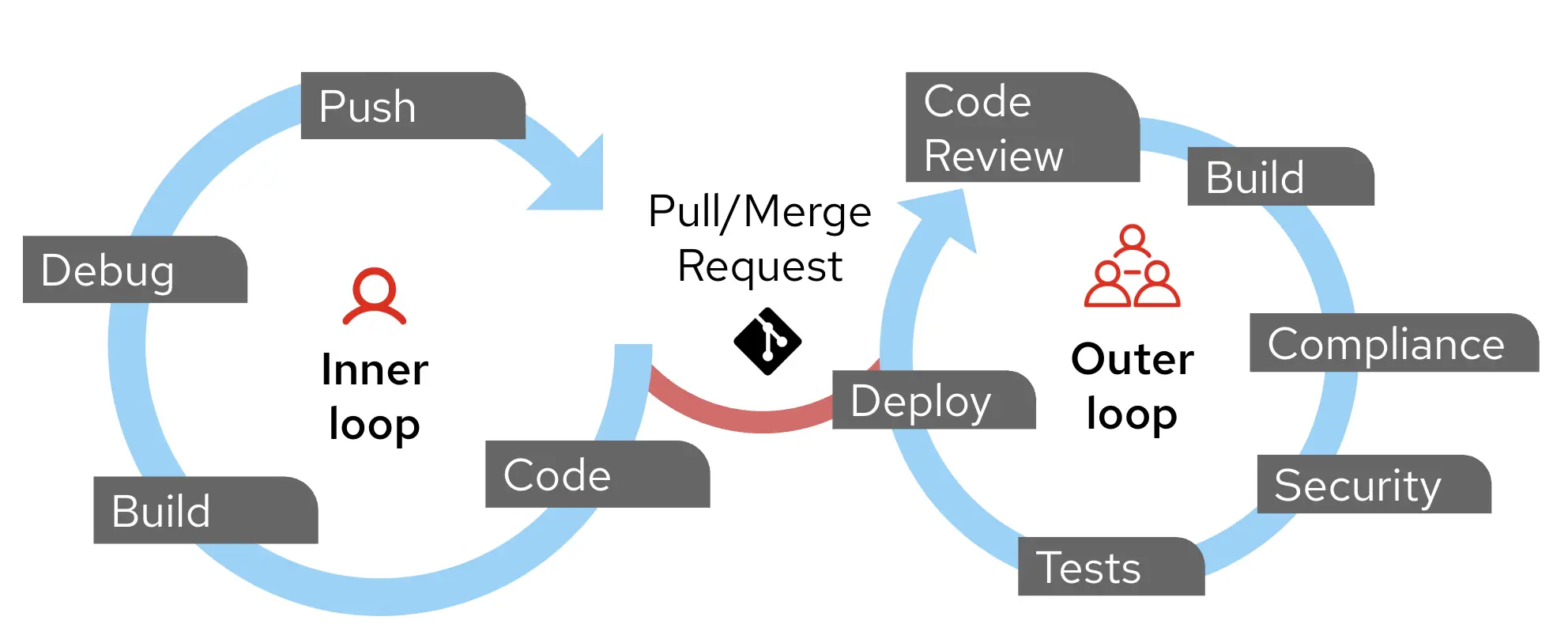Introduction to Concepts and Module Overview
Let’s look at a few concepts relevant to using Software Templates to import existing applications.
Catalog Info: A Refresher
You’ve already seen the magic of the catalog-info.yaml file. Red Hat Developer Hub can identify and import components based on the presence of a catalog-info.yaml file in the repository. This file contains:
-
Helpful links
-
Ownership information
-
Instructions on where to find the TechDocs
-
Relationships between the Component and other Entities
With the right plugins, configuration can be added to the catalog-info.yaml to show critical information in the Component view on Red Hat Developer Hub:
-
CI Pipelines
-
CD Deployments (as you saw with OpenShift GitOps already!)
-
Git Merge/Pull Requests and Issues
-
Cluster Details
-
API Documentation
What is Inner-Loop and Outer-Loop
Application development and deployment cycles can be defined to have an Inner-Loop and an Outer-Loop.

The Inner Loop is the iterative development cycle that developers follow when writing, testing, and debugging code locally before integrating it into a shared environment. Developers primarily live within the inner loop. In many organizations, the inner loop typically takes place on a developer’s computer. In this workshop the inner loop extends to an ephemeral (or preview) environment (namespace) on OpenShift that allows a developer to test their changes in a production-like environment.
| An Ephemeral environment is meant to be a transient environment to be used to build specific features, and can be torn down once the feature development is complete |
The Outer Loop begins when a developer pushes code to a version control system. It involves integration, validation, compliance and security checks, and deployment to target environments. Typically this is where Platform and DevOps Engineers operate.
The two cycles operate independently, except when the developer pushes code to Git, which triggers the outer loop.
An Opinionated Approach
| Different organizations have different ways of achieving the inner and outer loops. This module is a highly opinionated approach to the inner and outer loops. The primary intent is to showcase the art of the possible with Red Hat Developer Hub. |
To make the process of importing a large number of existing applications into Red Hat Developer Hub scalable, the Platform Engineering (PE) team creates a Software Template that automates both the creation of the catalog-info.yaml file and a TechDocs skeleton structure for developers.
The necessary Catalog Info and TechDocs could be stored in one of two locations for these existing applications:
-
The new files can be added to the same Git repository as the existing source-code.
-
Alternatively, a repository containing an Entity of
kind: Locationcan be created to store a collection of all of thecatalog-info.yamland TechDocs files. An Entity ofkind: Locationreferences other places to look for catalog data.
Parasol team’s approach
The Parasol team chooses the second approach to avoid adding files to existing source code repositories.
-
They create a dedicated repository called
all-location-parasolcontaining a Location file. -
This
Locationentity serves as a central index, referencing allcatalog-info.yamlfiles within the same repository.apiVersion: backstage.io/v1alpha1 kind: Location metadata: name: all-location-parasol description: A collection of Parasol components spec: type: url target: ./**/catalog-info.yaml -
Platform Engineers create Software Templates to import existing APIs, services and apps into Red Hat Developer Hub
-
Developers can register their components by using these Software Templates. The template auto creates a
catalog-info.yamlfile and a skeleton TechDocs for each component.
Red Hat Developer Hub can auto-discover these Location files based on the file and repository names (e.g all-location.yaml file in a folder which begins with the word all-location ) across Git. You can also configure a schedule that defines how often you want it to run. For this workshop we have a super short frequency of 15 seconds.
But, it is good practice to limit auto-discovery to specific filenames and be judicious with the scheduling frequency to ensure you don’t hit API rate limits with your Git hosting provider. Click here to learn more about GitHub rate limits.
all-location-entity:
filters:
branch: main
entityFilename: all-location.yaml
catalogPath: /**/all-location.yaml
projectPattern: \b(all-location\w*)
schedule:
frequency:
seconds: 15
initialDelay:
seconds: 15
timeout:
minutes: 3An Overview of Parasol Application
The Developer is asked to build new features into the existing Parasol application which consists of the following Components:
-
parasol-webonline web-app (Node.js & Angular) -
parasol-storecore services (Quarkus) -
parasol-dbcore database (PostgreSQL) -
parasol-api(OpenAPI Spec)
In the next sections of this module, we will shadow both the Platform Engineers and Developers as they navigate through onboarding existing applications and accelerate the inner-loop leading to increased developer productivity.